| Author |
Message |
|
Nathan Bell
|
 Posted: Sun 10 Oct, 2004 3:41 pm Post subject: Posted: Sun 10 Oct, 2004 3:41 pm Post subject: |
 |
|
Hi david, Kirk, and all:
Lots of good stuff, again.
Kirk is right, the Irish swords have spacers. On the Irish and earlier La Tene they seem to be bronze, Iron often later on. Either way, with bi-metallic contact you get accelerrated corrosion, or with iron to iron, they can corrode together...so seems natural that they "stick". So I guess I would slightly lean the other way on the fixation question, I suppose?....At least ont he expanded diagrams of the Lisnacrogher and Irish swords from Raftery, looks pretty clear these are just washers, not attached to the tang.
Llyn Cerig Bach are all square/rectangular tangs, original report not giving the thickness though. Kirk is right, predominantly squarish, occasional rounded---I'll not have to check my Navarro now, either.
2 questions answered in one, on spacers AND twisted tangs: Jeroen Z. has pics on his site posted from a Danish (?) museum, showing clearly both of these features on some continental La Tene blades---check it out http://mitglied.lycos.de/tgrb/leger_museum_de...index.html
On the Alloa sword, I am interested to see the associated finds just for the very reason Kirk broached upon---since it is British, and other British swords are often both narrower and pointer for their time period than Continental contemporaries, I want to see where it fits chronologically. Could be we have an earlier period blade, or a very nice British holdover, earlier style (vis a vis the Continent) in later time period. Inquiring minds want to know and all  Of course, ANY textile find is big, big, too. Of course, ANY textile find is big, big, too.
One more thing for Kirk: on the Cotterdale sword discussion above, you are absolutely right on the pommel orientation. I was able to sit down with Peter J. this weekend and look it over, he very quickly and specifically showed me why and how I was wrong about it!!! 
|
|
   |
 |
David McElrea

|
 Posted: Sun 10 Oct, 2004 4:47 pm Post subject: Posted: Sun 10 Oct, 2004 4:47 pm Post subject: |
 |
|
Kirk and Nathan,
Thank you both for your insights-- I am occasionally astounded (and generally thankful) that a forum such as this actually exists. Hats off to Nathan Robinson and co. as well for making all this possible!
Your comments on the roundness of the tang and the shortness of the blade are very helpful... thank you. I was sure they had to be feasible as weapons, but could not understand the physics involved.
Also, your theory, Kirk, on the twisted tang blades is most interesting!
Also, thank you both for your comments on the spacers. It is interesting that the spacers tend to be uniformly distanced by 3"-4". I would have thought that the placement of organic components would be easier if the spacers were placed on in the fashion of washers-- sandwiched, so to speak, before the pommel was secured in place.
I imagine the alternative (fixed spacers) would necessitate halves of wood/bone/ivory being glued or otherwise fastened together in place between each spacer-- this isn't impossible, but it would seem to be less economical time and work-wise.
In re: the Alloa sword-- I am in full agreement. From a British perspective, this is a unique find. From a Scottish perspective, it is huge! Also encouraging when we look across the Irish Sea to another land that has had limited Iron Age sword finds.
With the sword in question, it may turn out to be "local" or it may turn out to be an import-- either option is significant in its own way.
The Scottish find (if it is an import) reminds me that the peoples of the Atlantic seaboard were part of a highly effective trade network-- one shouldn't be surprised to find swords with different specs or more exotic origins (even if it's only as far away as Gaul). This could translate to Ireland as well (although the only "sure" example I know of is the anthro hilt from Donegal).
If it is local (i.e. British) then we have been given a new insight into British swords that we have not had before.
I would love to see Peter Johnsson's interpretation of this one (on paper and in steel, I mean  )... )...
Anyway, I'll try to keep posting as new info comes in.
Cheers once again,
David
|
|
  |
 |
Kirk Lee Spencer

|
 Posted: Sun 10 Oct, 2004 7:19 pm Post subject: Posted: Sun 10 Oct, 2004 7:19 pm Post subject: |
 |
|
| Nathan Bell wrote: | .
...with bi-metallic contact you get accelerrated corrosion, or with iron to iron, they can corrode together...so seems natural that they "stick". So I guess I would slightly lean the other way on the fixation question, I suppose?....At least ont he expanded diagrams of the Lisnacrogher and Irish swords from Raftery, looks pretty clear these are just washers, not attached to the tang...
 |
Excellent point... Especially considering David's insight that if the washers were directly attached to the tang it would be impossible to attach a cylindrical grip (which is all that I have seen on these swords).
However... I suppose that these LaTene cutlers could have used this sequence:
Sliding on the bronze guard plate then the wood guard
Then with a chisel, peen the tang behind to hold it in place.
Then slide on a washer and chisel/peen the tang behind this washer
Slide on the cylindrical grip chisel/peen behind it.
Slide on the next washer and chisel/peen behind it.
The thickening of the tang by peening would help (along with corrosion) to hold the washers in place after the organic material decayed. This would also help to stabilize each of the hilt components separately. If you look at the closeup of the hilt of the Cashel sword above it almost appears as if the tang is thicker on either side of the front washer. This might be indication of some peening...possibly... or it could just be corrosion. Sure wish there was not a gigantic pond between me and these artifact.... and I knew a few friendly curators.
Which reminds me... Nathan... you lucky dog. Being able to sit down with Peter Johnsson and talk about swords!!!
I would love to have a summary of some of the things you guys talked about.
ks
Two swords
Lit in Eden’s flame
One of iron and one of ink
To place within a bloody hand
One of God or one of man
Our souls to one of
Two eternities
|
|
  |
 |
|
Nathan Bell
|
 Posted: Mon 11 Oct, 2004 3:49 am Post subject: Posted: Mon 11 Oct, 2004 3:49 am Post subject: |
 |
|
Hi Kirk,
Once again, you beat me to it  In the shower this am I was thinking about how Albion "peens" their guards into place, and how this may have been done to the washers....I was going to post this very thing, and lo and behold, you're about a day ahead of me (at least) In the shower this am I was thinking about how Albion "peens" their guards into place, and how this may have been done to the washers....I was going to post this very thing, and lo and behold, you're about a day ahead of me (at least) 
Have no fear, my friend, I will be digesting the info we talked about, and I am sure he will also be bringing new insight to the materials I brought along. You *will* be hearing about stuff from the event, fear not....for me it's a matter of trying to organize alll the information in my tiny mind *g*
|
|
   |
 |
|
Patrick Kelly
|
 Posted: Mon 11 Oct, 2004 9:14 am Post subject: Posted: Mon 11 Oct, 2004 9:14 am Post subject: |
 |
|
| Nathan Bell wrote: | Hi Kirk,
Once again, you beat me to it  In the shower this am I was thinking about how Albion "peens" their guards into place, and how this may have been done to the washers....I was going to post this very thing, and lo and behold, you're about a day ahead of me (at least) In the shower this am I was thinking about how Albion "peens" their guards into place, and how this may have been done to the washers....I was going to post this very thing, and lo and behold, you're about a day ahead of me (at least) 
Have no fear, my friend, I will be digesting the info we talked about, and I am sure he will also be bringing new insight to the materials I brought along. You *will* be hearing about stuff from the event, fear not....for me it's a matter of trying to organize alll the information in my tiny mind *g* |
Hey Nathan!
I snagged the computer at Albion for a few minutes 
We were really sorry about saturday night. None of us realized that managment had locked the front door to the bar. We were all sitting around wondering where you were until Harlan walked in the back, and we then realized that the front door was locked. Very embarassing.
Anyway, it was great to meet you and I was very impressed by your knowledge of celtic arms as well as your enthusiasm for the subject.
"In valor there is hope.".................. Tacitus
|
|
   |
 |
|
Nathan Bell
|
 Posted: Mon 11 Oct, 2004 10:02 am Post subject: Posted: Mon 11 Oct, 2004 10:02 am Post subject: |
 |
|
| Patrick Kelly wrote: | | We were really sorry about saturday night. None of us realized that managment had locked the front door to the bar. We were all sitting around wondering where you were until Harlan walked in the back, and we then realized that the front door was locked. Very embarassing. |
Oh yeah, trying to ditch me eh? 
No I figured you guys didn't know about the door, and I knocked some but the staff had decided they didn't *want* any more customers, it seems.
Sorry I couldn't talk to you guys longer....would have at least said goodbye and thanked Peter for spending so much of his time with me there.
| Patrick Kelly wrote: | | Anyway, it was great to meet you and I was very impressed by your knowledge of celtic arms as well as your enthusiasm for the subject. |
You mean my nearly spastic level of intensity, eh?  Honestly, I am usually quite the low-key guy, but not with so much cool stuff to discuss and so many people to discuss it with.... Honestly, I am usually quite the low-key guy, but not with so much cool stuff to discuss and so many people to discuss it with....
|
|
   |
 |
David McElrea

|
 Posted: Mon 11 Oct, 2004 11:39 am Post subject: Posted: Mon 11 Oct, 2004 11:39 am Post subject: |
 |
|
Hi Kirk,
Excellent point-- and with regards to the Cashel sword, well spotted!
Looking at an enlargement of the Alloa Sword pic, it also seems to have spacers. It almost appears to have alot of the organic components left, but that may just be the oxidation...
I would dearly love to stop by and see these myself, up close and personal. The distance is negligible, but the likelihood of being allowed to handle them is moreso  It would probably be more worthwhile for someone to do it who knows what to look for anyway. Still, I may have to pop over to look at them through the glass-- and catch up with some family at the same time. It would probably be more worthwhile for someone to do it who knows what to look for anyway. Still, I may have to pop over to look at them through the glass-- and catch up with some family at the same time.
David
|
|
  |
 |
|
Patrick Kelly
|
 Posted: Tue 12 Oct, 2004 3:35 pm Post subject: Posted: Tue 12 Oct, 2004 3:35 pm Post subject: |
 |
|
| Quote: | | You mean my nearly spastic level of intensity, eh? Honestly, I am usually quite the low-key guy, but not with so much cool stuff to discuss and so many people to discuss it with.... |
Hey, I would have been quite spastic myself (and usually am when I get a rare opportunity to talk sword face to face) if I hadn't been suffering from the after effects of friday nights "merriment" 
"In valor there is hope.".................. Tacitus
|
|
   |
 |
David McElrea

|
 Posted: Mon 25 Oct, 2004 9:45 am Post subject: Posted: Mon 25 Oct, 2004 9:45 am Post subject: |
 |
|
A brief update on the Alloa find for anyone who is interested.
I managed to get in touch with the "Glasgow University Archaeological Research Division" (GUARD) earlier this month to enquire about the Alloa project's status and to ask when they are thinking of publishing their findings.
They are aiming to publish late next year, so we'll have a bit of a wait... it should be worth it though.
Their website, incidentally, is http://www.guard.arts.gla.ac.uk/
Yours,
David
|
|
  |
 |
Kirk Lee Spencer

|
 Posted: Wed 10 Nov, 2004 7:21 pm Post subject: Mill Hill Deal Grave 112 (c. 200 B.C.) Posted: Wed 10 Nov, 2004 7:21 pm Post subject: Mill Hill Deal Grave 112 (c. 200 B.C.) |
 |
|
| David McElrea wrote: | A brief update on the Alloa find for anyone who is interested.
I managed to get in touch with the "Glasgow University Archaeological Research Division" (GUARD) earlier this month to enquire about the Alloa project's status and to ask when they are thinking of publishing their findings.
They are aiming to publish late next year, so we'll have a bit of a wait... it should be worth it though.
Their website, incidentally, is http://www.guard.arts.gla.ac.uk/
Yours,
David |
Well, while we wait for the report on the Alloa find in the northern part of the island, I thought you might want to see a similar find from the southern part. It is grave 112 from the excavations of a barrow at Mill Hill in Deal (East Kent... I think). This grave dates to about 200 B.C. and is part of a regional burial ground spanning over 2000 years. It contains a male skelaton, thirty something in age--shield over left side of the body, bronze headband (or crown) on his head, LaTene sword resting on top of the right arm, decorated part of the scabbard face down. Nearby is a large suspension ring with coral beads believed to be part of the sword belt.
Sword is 78.6 cm overall length.
Hilt made of bone in two parts with a 5mm thick iron washer between the parts. Bell shaped guard is also made of iron.
The scabbard seems to have been made for another similar sword. The blade is LaTene I but the scabbard mounts would suggest a LaTene II age. So the report puts the date at early LaTene II (c. 200 B.C.)
ks
 Attachment: 64.69 KB Attachment: 64.69 KB
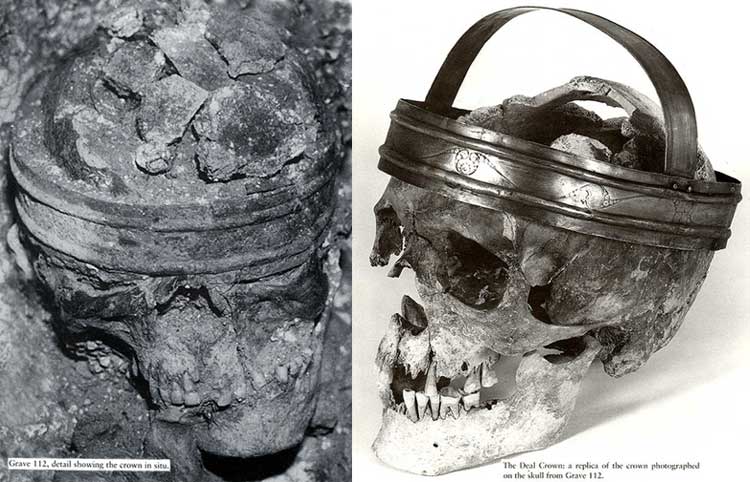
Skull with crown left. To the right is the skull reconstructed with an exact replica of the crown
 Attachment: 88.32 KB Attachment: 88.32 KB
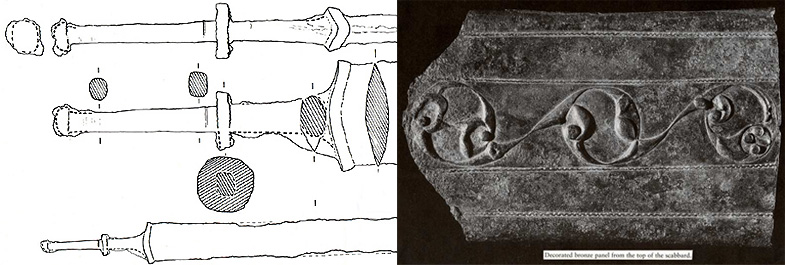
Left is an Archeological drawing of sword. Right is a picure of the bronze panel on the upper part of the scabbard.
 Attachment: 78.83 KB Attachment: 78.83 KB
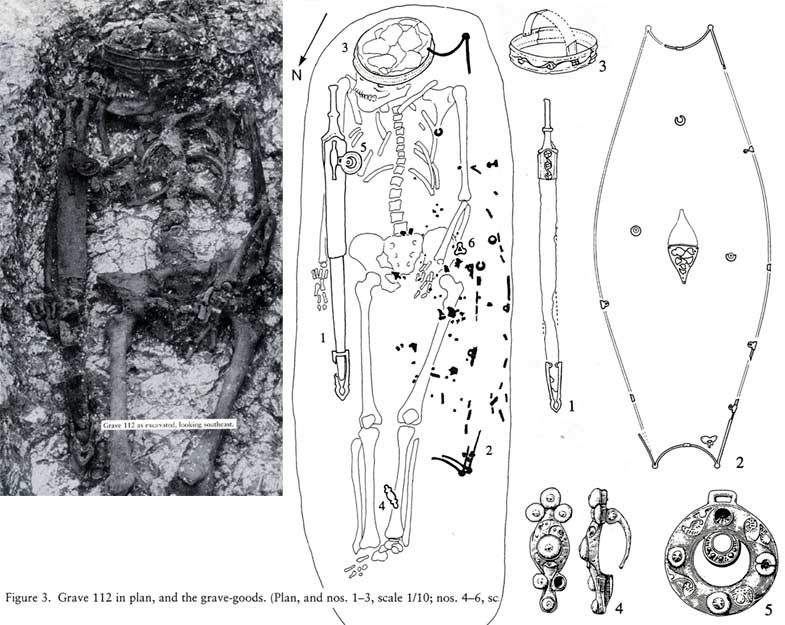
Grave 112 Mill Hill.
Note the LaTene sword to the left and the edging of hide shaped shield just to the right of the skull.
Two swords
Lit in Eden’s flame
One of iron and one of ink
To place within a bloody hand
One of God or one of man
Our souls to one of
Two eternities
Last edited by Kirk Lee Spencer on Thu 11 Nov, 2004 7:13 pm; edited 1 time in total
|
|
  |
 |
Nate C.

|
 Posted: Wed 10 Nov, 2004 7:54 pm Post subject: Posted: Wed 10 Nov, 2004 7:54 pm Post subject: |
 |
|
Very interesting pictures, especially the "crown". It almost looks like it could have been a helm originally. One thing I'm kind of curious about is who was this poor guy that they would bury him holding his head?  
Interesting isn't it?
Nate C.
Sapere Aude
"If you are going to kill the man, at least give him a decent salute." - A. Blansitt
If they ever come up with a Swashbuckling School, I think one of the courses should be Laughing, then Jumping Off Something. --Jack Handy
|
|
  |
 |
Kirk Lee Spencer

|
 Posted: Wed 10 Nov, 2004 8:50 pm Post subject: Posted: Wed 10 Nov, 2004 8:50 pm Post subject: |
 |
|
Hey Nate...
The report said that he was of "slight" stature. I guess this means he was a short person. When they chipped his grave out of the limestone they must have thought he was even shorter... So, rather than taking him out and chipping away a little more, they just leaned his head up against the end of the grave forcing his chin down on to his chest. As the body disintegrated it does appear that he is holding his own head. 
If the crown were a helm it was not a very good one. The bronze strips are thin and held together by one rivet at each joint.
There is a netting of tiny ridges of corrosion on the inside the crown, believed to be where the hair on his head caused a higher degree of corrosion as each one decayed.
ks
Two swords
Lit in Eden’s flame
One of iron and one of ink
To place within a bloody hand
One of God or one of man
Our souls to one of
Two eternities
|
|
  |
 |
|
Nathan Bell
|
 Posted: Thu 11 Nov, 2004 8:42 am Post subject: Re: Mill Hill Deal Grave 112 (c. 200 B.C.) Posted: Thu 11 Nov, 2004 8:42 am Post subject: Re: Mill Hill Deal Grave 112 (c. 200 B.C.) |
 |
|
| Kirk Lee Spencer wrote: |
Sword is 78.6 cm overall length.
Hilt made of bone in two parts with a 5mm thick iron washer between the parts. Bell shaped guard is also made of iron.
The scabbard seems to have been made for another similar sword. The blade is LaTene I but the scabbard mounts would suggest a LaTene II age. So the report puts the date at early LaTene II (c. 200 B.C.)
ks |
Hi Kirk,
Is there any way that you could reproduce or paste in the text where they analyze the find for dating? I am very interested in what features they consider most heavily, etc.
Also, is this from the fairly recent (1995) analysis of the grave group, by Parfitt, or is it from the first, earlier excavation reports? And, if it's from the 1995 Parfitt, is it one of the sections reprinting the earlier analyses?
One reason I am asking is that dating these British finds is so dicey, given that they vary from the continnet in hilt and scabbard mounting styles, and the fact that older traditions in armamment and decoration lingered longer in Britain, and the fact that the British swords were quite often a good bit smaller than the Continental counterparts, and more often retained a sharp point well into La Tene III and IV (leading earlier reports to erroneously classify some blades as La Tene I simply based on size and the fact they have a point).
Looking at the blade drawing, I am assuming a lentoid cross-section, and a rather graceful, even taper which steepen slightly (not dramatically) in the last 1/3, curving to a sharp point? If this is relatively accurate description, then the blade form and proportion lends itself quite, quite well to be in the solid "middle" of the Middle La Tene, as the report finally concludes?
It may be that the fact that it is likely shorter than the average Middle La Tene made the original excavators classify the blade as La Tene I. But "looks" wise, propotion, cross section it seems solid center La Tene II---for similar blade shape and profile tapers, cross sections, look at the actual La Tene find Middle La Tene blades from Navarro, plates XII, XIII, XVI, XXI, XXIII, XXIX (left 4 pics), XXX (leftmost sword), XXXII, XXXV (2nd from left) XXXVII(center sword), XXXVIII, XLII, and XLIII
This solidly middle La Tene blade form is virtually unrepresented in modern replicas, and clearly refutes the common assumption that La Tene II blades had very little taper and rounded or spatulate points----features that really do not appear until the end of La Tene II and continue into La Tene III.
|
|
   |
 |
|
Nathan Bell
|
 Posted: Thu 11 Nov, 2004 8:51 am Post subject: Posted: Thu 11 Nov, 2004 8:51 am Post subject: |
 |
|
Another very interesting thing that Kirk very nicely pointed out---the shield bindings.
This particular burial had the most complete set to date at that time of bronze bindings for the distinctively British "hide-shaped" shield---a form almost unrepresented in arachaeological evidence of Continnetal celtic shields
With this find the scientists were finally able to "put the pieces together" literally to reconstruct the Hide-shaped shield previously known only from minuature votive shields and earlier, much more fragmented bindings (which were not correctly identified until this find shed light on the subject!)
I'll try to see if I can post a pic of my all-organic reconstruction of this shield form, later.
N
|
|
   |
 |
Kirk Lee Spencer

|
 Posted: Thu 11 Nov, 2004 8:06 pm Post subject: Re: Mill Hill Deal Grave 112 (c. 200 B.C.) Posted: Thu 11 Nov, 2004 8:06 pm Post subject: Re: Mill Hill Deal Grave 112 (c. 200 B.C.) |
 |
|
| Nathan Bell wrote: |
Hi Kirk,
Is there any way that you could reproduce or paste in the text where they analyze the find for dating? I am very interested in what features they consider most heavily, etc.
Also, is this from the fairly recent (1995) analysis of the grave group, by Parfitt, or is it from the first, earlier excavation reports? And, if it's from the 1995 Parfitt, is it one of the sections reprinting the earlier analyses?
|
Hi Nate...
I will try to paste into this post the sections on the sword and scabbard that has some relation to typology and chronology... Not sure if will interest any one other than me an you   But it will give others an opportunity to see how these archeological types try to get handle on chronologies based upon the details of material culture. Also a good example of a cluster analysis. But it will give others an opportunity to see how these archeological types try to get handle on chronologies based upon the details of material culture. Also a good example of a cluster analysis.
As for the text... it is a slim book published in the 90s just on the Grave 112 find. I have the bibliographic info at my office I will try to post it tomorrow.
As for the blade... I had the same feeling as you. When I saw it I thought it was LaTene II but then was suprised that the report dates it as LaTene I. I felt a little justified when the scabbard mounts carried it into LaTene II. I think you are right about the anachronistic elements in celtic culture of Britain. We certainly see the Scottish and Irish hanging on to design elements long after they have changed on the continent. So it seems reasonable that this trend could have occured earlier.
Here is the text... enjoy! 
“Warrior burial (Grave 112)
1. Sword and scabbard (Figs.14,15)
A corroded iron sword 786mm on of which the blade is 643mm long...
The blade is thickened in the centre (12mm at the top) but without an obvious median ridge. Its taper is not easy to assess because of corrosion at the edges: from a width of 49mm at the top there seems to be little decrease to the damaged area, below which it tapers markedly to a point. It seems likely to have tapered for the final 190mm, between ¼ and 1/3 of the length of the blade... The handle had been made of bone... and constructed in two lengths divided by a fairly thick (5mm) iron washer. (Stead 1991a for two part handles)... At the top of the tang, above the mineral preserved organics, is a pronounced but corroded knob, and at the bottom of the handle a separate iron hilt-end with a very low curve - only 5mm high on one face and 7mm on the other. The scabbard, made of leather or wood with bronze fittings, had been about 660mm long. There is a bronze panel at the top, on the front, 95mm long and 59mm wide at the top (expanding to 61mm wide at the bottom), with a high campanulate mouth - much higher than the
iron hilt-end of the sword (16mm as opposed to 5-7mm) which suggests that sword and scabbard were not originally intended for one another (pI. VIII; fig. 15, a) About 11 mm below the mouth on the inslde of the front panel is the impression of part of another curve, shallowerand more in keeping with the shape of the present hiltend. The panel is very slightly down-curved at the bottom and has broad overlaps deeply rounded to clasp the presumed leather scabbard and cover the edges of a bronze back panel; the rounded edges continue to the front where each is bordered by a notched rib. Similar notched ribs define a central vertical panel decorated with an overall repousse design (p. 93). The bronze back-panel is 315mm long, much longer than the front panel, and 53mm wide with a campanulate mouth as high as that on the front panel (fig. 15,c). Its bottom end is straight, with no hint of rivets or any other form of attachment to the resumed leather scabbard...
The Deal sword has a typical La Tene I blade, tapering between 1/4 and 1/3 of its length to a sharp point (de Navarro 1972, 21 and 40). lts scabbard Is more unusual, made of either leather or wood (no trace of organics in the corrosion products of the metal), but with a decorated bronze panel at the top - an arrangement that can be matched on three other British scabbards, from Shepperton, Standlake and the River Witham (for references see p. 63, nos 2, 3 and 26). The lower edge of the Shepperton and Witham panels follow the complex shapes of their repousse ornament, crossing the scabbards diagonally. Each has a short iron panel on the back, overlapped by the bronze front panel. But the Standlake panel is square, serrated at the bottom, has no overlaps (it may have had a separate metal binding), and no surviving metal back panel. Of these scabbards only Shepperton now has a suspension loop (Witham has a rivet hole from a loop-plate), which is long, narrow and band-shaped with rounded loop-plates - a typical La Tene I form (see de Navarro 1972, type la). The Deal suspension loop is also long and narrow, but the loop-plates are elongated, and it is attached to a bronze back plate which is far longer than its iron counterparts on the Shepperton and Witham scabbards. The contrast between Deal on the one hand and Shepperton and Standlake on the other, is much more marked when the chapes are compared. Shepperton and Standlake are similar, with iron chapes bridged front and back, and rounded open chape-ends. Within are bronze panels, each decorated to correspond with the ornamented panel at the top. Unfortunately the Witham chape is now lost: an early illustration (Willson 1852) shows some bronze that may have been the remains of a panel within the chape or perhaps the chape itself. With rounded open chape-ends and chapes bridged front and back, Shepperton and Standlake are La Tene I pieces. The Deal chape is very different: it is made of bronze, not iron; bridged on the back but clamped on the front; it lacks the decorated panel and its chape-end is heartshaped. These features relate Deal to another group of scabbards, typologically later than the trio discussed above. Iron chapes bridged on the back and clamped on the front are typical of La Tene I and II scabbards on the continent, and they also occur on La Tene I scabbards in Britain (e.g. from London, no. 4, and the River Witham, no. 5). One from Fovant (no. 6) has similar bridge and clamps, but the chape-end is closed, so it should be classified as a La Tene II form (de Navarro 1972, 33, fig. 12, no. 6, type Bi). The chape from Deal is a bronze version resembling Fovant, but with more elaborate details and designed for a slightly more tapering blade. A chape from Little Wittenham (no. 9; fig. 17) is similar but without the details, and with the addition of decoration on the back - an openwork design, resembling in technique the decoration on the boss of the Deal shield (p. 93). Otherwise the closest British chapes are from Spettisbury (Piggott 1950, fig. 3, 6) and a very crude example from Hunsbury (no. 8) both designed for blades with very little taper. The Deal sword and scabbard may be compared with others from Britain by establishing a typology of scabbards and relating them by plotting the measurements of the sword-blades they enclose. The typology of scabbards relies very much on the form of the chape (fig. 16): A, iron, with rounded open ends; B, iron, narrower and more pointed than A, but still open; C, iron Figure 17. The back of a bronze chape from Little Wittenham. Drawn by Robert Pengelly. (Full size) or bronze, close-fitting and heart-shaped; D, bronze, larger and more developed than C, the 'chape-clamps' separate and purely decorative; E, bronze, elongated heart-shaped chape-ends, most on laddered chapes; F, bronze laddered chapes with thickened rounded ends; G, bronze scabbards with wrapped rounded ends that have no need for chapes. In the diagram (fig. 18) the seven groups of scabbards are distinguished and plotted according to the length and top width of the sword-blades they held. The importance
of blade and scabbard measurements has been demonstrated for the site of La Tene (de Navarro 1972), has some validity in Champagne (Stead 1983), and seems equally significant in southern England. A sequence of the typological groups can be distinguished on fig. 18, with A and B followed by C on the left, then D, and finally E, F and G together on the right. Scabbards on the left (A and B) have typical La Tene I chapes, whilst those on the right are typical of La Tene III, including both laddered chapes (E and F) and scabbards rounded at the ends (F and G). Those in the middle of the diagram (C and D) have measurements that compare favourably with those of La Tene II swords from La Tene. Four other swords and a scabbard-plate, that cannot be grouped because the scabbards lack chapes, have been plotted on fig. 18. Within or near the La Tene I Groups A and B are swords from Battersea and Hammersmith Bridge (nos. 22 and 23), in scabbards decorated with dragon pairs, and one from Fiskerton (no. 24) the same site as artefacts with Waldalgesheim Style decoration. The Sutton scabbard-plate (no. 25), whose decoration is discussed below, has measurements very similar to the Group C Fovant scabbard. But the Duke of Northumberland's Witham sword (no. 26) appears to be an anomaly: it is the shortest of the swords plotted here, whereas its decoration would be more in keeping with a length around 600mm. However, apart from that one example all the swords and scabbards plotted in fig. 18 seem to occur in a chronological sequence consistent with both typology and the development of La Tene art in Britain. Swords and scabbards found north of the Humber have been omitted from this exercise because they do not increase in length as the Iron Age progresses (Stead 1991a, 64). The La Tene I scabbards from Wetwang Slack and Kirkburn would fall in their expected positions in the diagram, grouped at the bottom left, but the much more developed scabbards from Grimthorpe and Bugthorpe held swords of very similar length, well within the Group A range. The Deal sword, then, has a blade of La Tene I shape, its scabbard has features comparable with La Tene I scabbards from Shepperton and tandlake (Group A), its chape is more like La Tene II forms (Group II the measurements of the sword blade (fig 18, no. 7) are consistent with a date early in La Tene II, perhaps 200 BC.”
ks
 Attachment: 79.24 KB Attachment: 79.24 KB
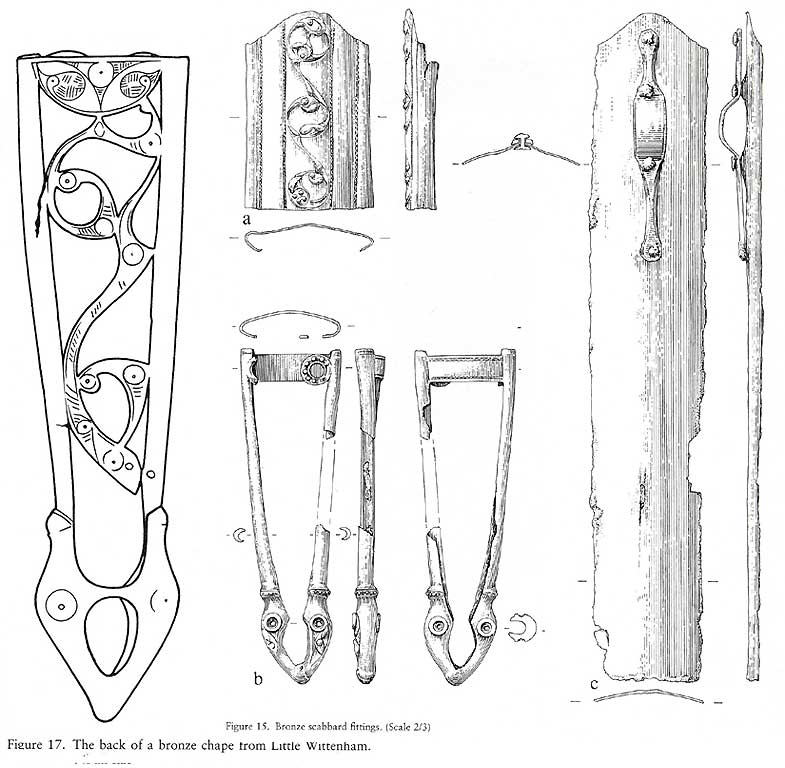
 Attachment: 52.17 KB Attachment: 52.17 KB
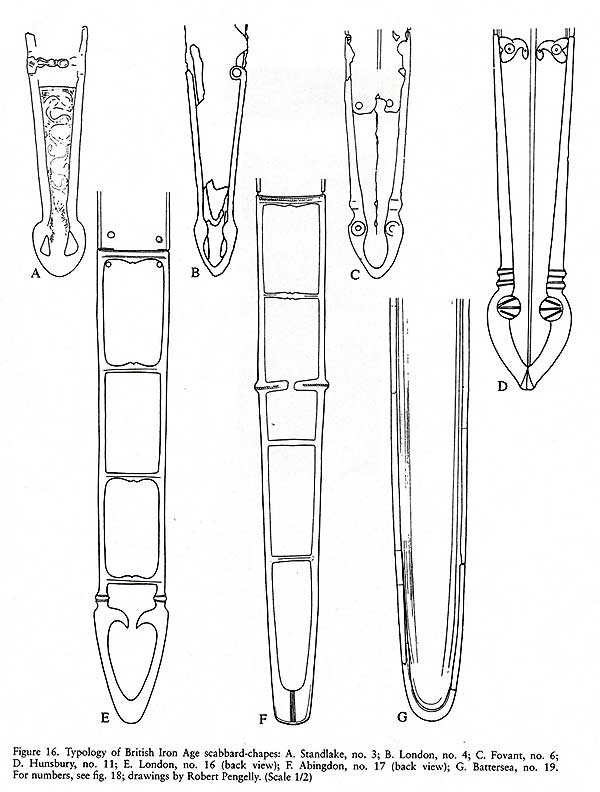
 Attachment: 79.92 KB Attachment: 79.92 KB
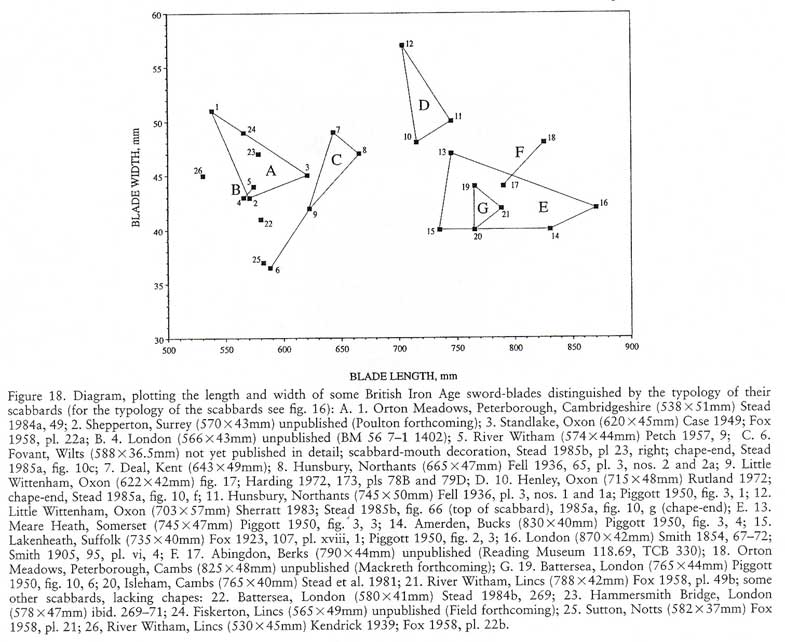
Two swords
Lit in Eden’s flame
One of iron and one of ink
To place within a bloody hand
One of God or one of man
Our souls to one of
Two eternities
|
|
  |
 |
Folkert van Wijk

|
 Posted: Fri 12 Nov, 2004 1:56 am Post subject: Quied, yet still interrested and reading... Posted: Fri 12 Nov, 2004 1:56 am Post subject: Quied, yet still interrested and reading... |
 |
|
Kirk Lee Spencer wrote:
| Quote: | | will try to paste into this post the sections on the sword and scabbard that has some relation to typology and chronology... Not sure if will interest any one other than me an you |
Don't whorry Kirk your posts are verry interresting indeed!!   Ad least for one more then just the two of you.. Ad least for one more then just the two of you..
I am just speachless and I just have nothing to ad... and am reading throu the posts. O my what a long one's!!
p.s. I am coing to see te military museum in Delft tommorow anything peticular I have to look for??
A good sword will only be sharp, in the hands of a wise man…
I am great fan of everything Celtic BC, including there weapons.
|
|
  |
 |
Kirk Lee Spencer

|
 Posted: Fri 12 Nov, 2004 6:50 am Post subject: Posted: Fri 12 Nov, 2004 6:50 am Post subject: |
 |
|
Hey Folkert...
Thanks for the encouragement... Sure wish I had such easy access to museums with real weapons. I envy you. Have a great time at Delft and keep postin.
Hey Nate...
You were right on the citation... it is Parfitt. Here is the info that I have.
"Iron Age Burials from Mill Hill, Deal"
edited by Keith Parfitt
ks
Two swords
Lit in Eden’s flame
One of iron and one of ink
To place within a bloody hand
One of God or one of man
Our souls to one of
Two eternities
|
|
  |
 |
|
Nathan Bell
|
 Posted: Fri 12 Nov, 2004 9:03 am Post subject: Posted: Fri 12 Nov, 2004 9:03 am Post subject: |
 |
|
| Kirk Lee Spencer wrote: | Hey Folkert...
Thanks for the encouragement... Sure wish I had such easy access to museums with real weapons. I envy you. Have a great time at Delft and keep postin.
Hey Nate...
You were right on the citation... it is Parfitt. Here is the info that I have.
"Iron Age Burials from Mill Hill, Deal"
edited by Keith Parfitt
ks |
Hi Kirk,
First off, thanks for posting that data, I think it's very helpful to the discussion. It points out for others than us  the differences between the British pieces and the Continnet, and the standards that help one differentiate timelines in "celtic" material generally. In that respect, I think a lot of others besides you and me will be helped. the differences between the British pieces and the Continnet, and the standards that help one differentiate timelines in "celtic" material generally. In that respect, I think a lot of others besides you and me will be helped.
Also helps diffuse the myth of the La Tene II sword I mentioned earlier---for the majority of the period, you have a tapering blade with a fairly sharp point.
Well, that and I recently got a French book dealing specifically with theories and systems of chronology and am a bit jazzed about that issue right now. 
A few comments on reading the material: It does cite Navarro's differentiation of blade types. It does not adequately note, however, that on that same page reference Navarro clearly states that in early La Tene II (Middle La Tene A in the dating terminology he sets, and others now follow) the blades in shape and profile taper continue to follow a La Tene I form. I think this is overlooked in modern times, and in survey books that in the early Middle LA Tene---say 260---190's or so you may be able to find sword with a "La Tene i" type of taper and blade character, but lengthened slightly, decreased in breadth slightly and with La Tene II scabbrd features. Then overlapping this period and going into the 2nd century BC you see the subtle taper diamond or lentoid blade, slimmer and longer, but still with serviceable thrusting point (these blade types I described above and referenced in Navarro plates)....I think these blade forms are overlooked in our English language books and pretty much unkown in replicas, though they are very common Middle La Tene forms
A second point that I realized I had assumed but not stated (again maybe beating a dead horse for you or I but maybe not apparent for the intiate): According to writers like Piggot (Swords and Scabbards of the British Early Iron age) and Stead, Truly British forms of the Celtic sword are non-existant for the Early La Tene period---apart from a very few scattered direct imports, the early period of La Tene is unrepresented in British weapons. Piggot states that aside from the rather "exotic" and sparse imports "the whole sword and scabbard series lies in the centuries after about 150 BC" (Piggot at pp3.)
Thus, the thrust of my point is that if that date is correct, the author has brought to light the first instance of a British native-styled LA Tene I sword, before about 150 BC. However, I am leaning toward the idea that the blade style is actually a Middle La Tene style, of Navarro type Middle La Tene A or even the "middle middle" period style of the first part of Middle La Tene B. I do not believe it is quite the early La Tene outlier that it first appears. This is simply my conclusion looking at the research data as a whole, a direct photo of the blade would help a bit more 
Anyways, thanks for posting that, I will have to order that article. (Money has been going more to the swords than the books lately)
Cheers all,
N
|
|
   |
 |
Chad Arnow
myArmoury Team


|
 Posted: Sat 13 Nov, 2004 1:48 pm Post subject: Posted: Sat 13 Nov, 2004 1:48 pm Post subject: |
 |
|
Hey folks,
Nathan Bell asked me to post a pic of his Celtic shield since it relates to this topic. He'll be able to answer any questions people may have about it.
 Attachment: 31.69 KB Attachment: 31.69 KB
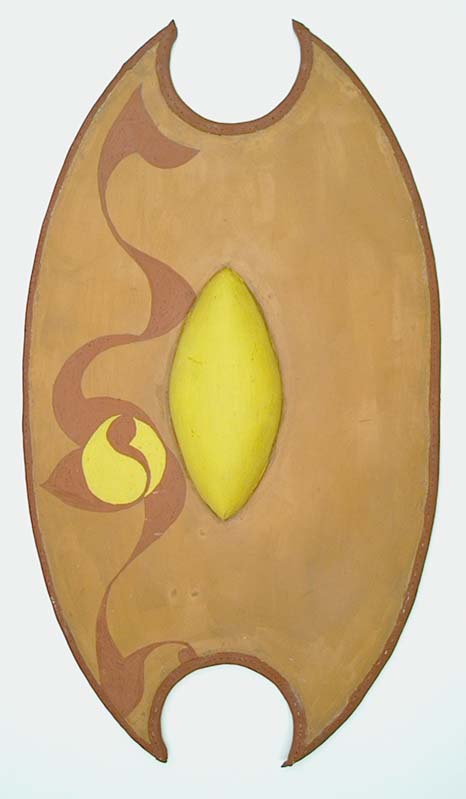

ChadA
http://chadarnow.com/
|
|
    |
 |
|
Nathan Bell
|
 Posted: Sat 13 Nov, 2004 4:51 pm Post subject: Posted: Sat 13 Nov, 2004 4:51 pm Post subject: |
 |
|
| Chad Arnow wrote: | Hey folks,
Nathan Bell asked me to post a pic of his Celtic shield since it relates to this topic. He'll be able to answer any questions people may have about it. |
Thanks Chad!
This is my reconstruction of the distinctive British hide shaped shield. This form really revealed itself with a set of complete bronze edge bindings found in the Mill Hill, Deal grave 112, as Kirk noted above. Before this time, only fragmentary bindings survived, or nothing at all, and the only clues to this shield type were through icons and later, miniature bronze votive shields
Mine is all organic in construction, with a rawhide edge binding, rather than the more fancy bronze. I based it on features from several of the Salisbury minature votive shields, and the size was roughly taken from the Mill Hill grave 112 bindings, above. Design is taken from one of the Salisbury minatures, as well.
Edit:
The painted design taken from Salisbury votive shield #2. The overall shield shape taken from Salisbury votive shields #'s 3, 5, 6, 18, and 19. The boss shape taken from Salisbury votive shields #'s 13, 16, 17, 18 and 21.
See I.M. Stead's "Many More Iron Age Shields from Britain" for more detail on this type of British shield
N.
Last edited by Nathan Bell on Sun 14 Nov, 2004 2:52 pm; edited 1 time in total
|
|
   |
 |
|
|
You cannot post new topics in this forum
You cannot reply to topics in this forum
You cannot edit your posts in this forum
You cannot delete your posts in this forum
You cannot vote in polls in this forum
You cannot attach files in this forum
You can download files in this forum
|
All contents © Copyright 2003-2024 myArmoury.com — All rights reserved
Discussion forums powered by phpBB © The phpBB Group
Switch to the Basic Low-bandwidth Version of the forum
|

